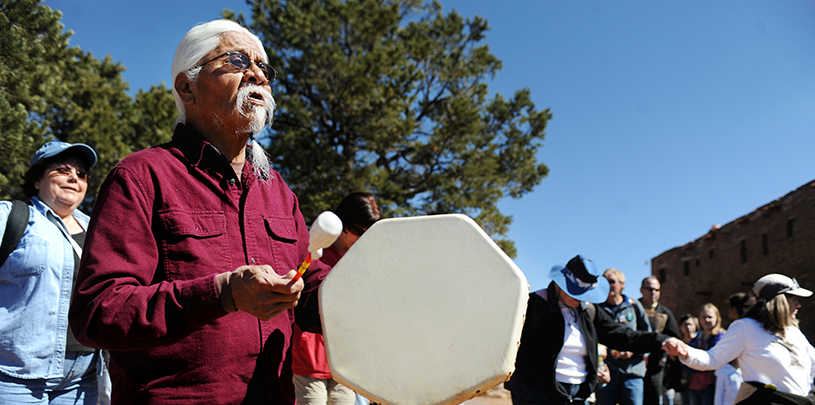
 by Sarana Riggs, Grand Canyon Manager
by Sarana Riggs, Grand Canyon Manager
Greetings, friends. It is with deep respect that we honor the life of former Havasupai Tribal Chairman Rex Tilousi, who passed away on June 19, 2021. Here at the Grand Canyon Trust, we highly respected Mr. Tilousi’s passion and advocacy on cultural and environmental issues impacting his homeland and lands and waters beyond the traditional borders of the Havasu 'Baaja – the People of the Blue-green Waters.
We, the Havasupai, believe that we lived within the Mother Earth. The place of emergence where we came out to the surface of our Mother Earth is within the Grand Canyon Area. We emerged from the Grand Canyon, from within the earth. We migrated up to the rims of our Canyon home. There we lived in peace, in harmony with plantlife and wildlife, our Mother Earth, the waters, the air, the sun, the moon. These we regard as our relatives. We lived within the Grand Canyon area with the waters, the springs that we have in our Canyon home. We lived in the Canyon in the summer, we migrated up to the plateau areas in winter. This is how we lived within the aboriginal lands we once roamed, where we once prayed, the mountains, the beauties that we regard as very sacred. – Rex Tilousi
Mr. Tilousi spoke highly about his upbringing and the teachings he received from his elders. This wealth of knowledge was information that had been passed down through the generations. This knowledge could not be found in textbooks or on websites, but could only be heard in prayer, song, ceremony, and lessons which were learned daily. This knowledge could only be found within the confines of one of the most beautiful places in the world, a place like no other, a place surrounded by tall red-mauve walls, blue-green waters with majestic waterfalls, and lush gardens, and, on the canyon’s rims, in a forest which supplied food, warmth, and supplies for the Havasupai people.
If you had the pleasure of meeting Mr. Tilousi, you know he will always be remembered as a well-respected leader who spoke eloquently and passionately about the true history of the Grand Canyon and what that meant to the Havasupai people.
He reminded us of a time when the people lived peacefully above the canyon in their vast traditional lands. He also stressed the importance of water and how it sustained life in the Grand Canyon for all living beings. There was beauty, strength, and resiliency in his words as he spoke about the land he grew up on.
We were given a responsibility to protect and preserve this land and water for those yet to come. We have a job to do. The ancient rock writing in our canyon tells us to protect this place. The canyon doesn’t belong to us. We belong to the canyon, to the earth, to the water. It created us and gave us life. We are fighting for our lives and for those who are yet to come. – Rex Tilousi
He testified before Congress, interpreted the canyon for tourists, and served as an elected and respected cultural leader. At gatherings at the South Rim, Red Butte, and public hearings, he sang “No More Uranium Mining” accompanied by drumming and round-dancing. He spoke up for protecting springs, the Little Colorado River, and the entire Grand Canyon, serving as one of its most powerful guardians. Mr. Tilousi was an honored elder who contributed to intertribal conversations and collaborations.
Whenever Rex left the canyon to pursue education or work, the canyon and the people always called for him to return home and that is where he is now — Mr. Rex Tilousi has returned home. Thank you, for everything you have taught us. We will miss your grace and good humor. You leave behind future generations who will continue to carry your teachings and voice with them to ensure the safety and legacy of the Havasu 'Baaja.
80% of Arizona voters support Baaj Nwaavjo I'tah Kukveni National Monument, according to a new poll.
Read MoreUtah voters strongly support national monuments in general, and Bears Ears and Grand Staircase-Escalante in particular, a new poll shows.
Read MoreA small victory in the legal case challenging Daneros uranium mine, near Bears Ears National Monument.
Read More